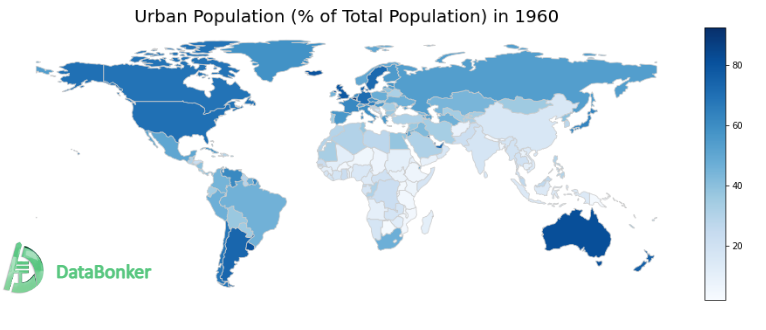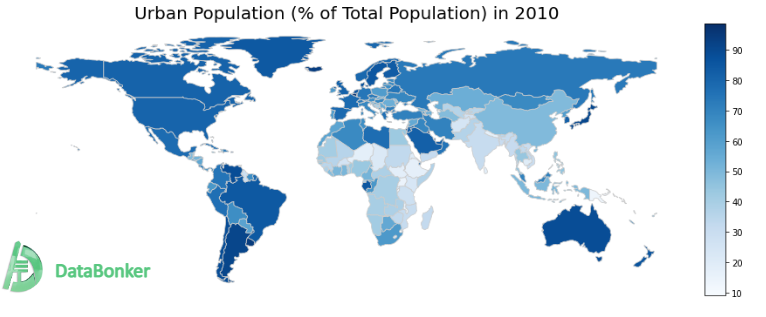What is Urbanization? The process of urbanization is how cities grow and a growing section of the population relocates there to live. It could also be characterized as a steady increase in urban and rural populations. The notion that urban areas have excelled over rural ones in terms of economic, political, and social growth strongly influences it.
Urbanization is very common in both developing and developed countries because more and more people want to live closer to towns and cities to get “privileged” social and economic services and benefits. These include social and economic advantages such as better housing options, employment opportunities, access to transportation, access to health care, education, and hygienic conditions.
Today, in this article we will be looking at the overview and some brief points related to urbanization trends.
Various causes of Urbanization
- World War II led to an expansion of government services.
- population mobility during the partition of India.
- a revolution in the industry.
- 11th five-year plan, which stressed the importance of urbanization to India’s economic development.
- Economic opportunity is one of the many reasons people move to cities.
- Infrastructure facilities in cities.
- Around 1990, the private sector grew.
- People from rural areas and smaller cities are moving to large towns as a result of the growth in jobs in urban areas. India’s urban population will increase from 340 million in 2008 to 590 million in 2030, predicts Mckinsey.
- People move out for economic advancement to places with better work prospects, which is being pushed by economic compulsions.
- The destruction of communities owing to the building of roads and highways, the construction of dams, and other activities also contribute to the fragmentation of the land.
Levels of Urbanization in the World
Using a mix of geographic closeness and population density, local administrative units (LAUs) are classified as cities, towns, suburbs, or rural regions depending on the degree of urbanization using minimum population thresholds applied to 1 sq. km population grid cells. Degree of Urbanization classifies local units into three groups based on population density, size, and contiguity using 1 sq. km grid cells: “cities” or “densely inhabited regions,” “towns & semi-dense areas” or “intermediate density areas,” and “rural areas” or “thinly populated areas.”
Data Patterns and Statistics of Urbanization in the World: Demographic Changes, Economic Development, Consumption Pattern, Urban Footprint
North America, Western Europe, South America, and Australia all have high rates of urbanization. Africa and Asia have lower rates of urbanization than other parts of the world, although as was already said, these regions are rapidly urbanizing overall, catching up to other regions.
A significant milestone was reached in 2010 when the global urban population for the first time in history surpassed 50%. According to the UN’s World Health Organization, “by 2030, six out of ten people will live in cities, and by 2050, seven out of ten people will do so.” 1 For the global populace and its leaders, this raises basic problems and issues, some of which are explored in this unit.
- According to UN statistics, 4.219 billion of the world’s 7.632 billion inhabitants — or 55.3% of all people live in metropolitan areas.
- Even though it might seem like our expanding cities take up a lot of areas, only roughly 1% of all land is thought to be developed.
Patterns of Urbanization in Asia
Let’s talk about Asia! Even though the Asian continent is becoming more urbanized, Asia’s population is still primarily rural. However, in 2010, urbanization rates varied widely, from 33% in South and South-West Asia to 63% in North and Central Asia to 70% in the Pacific.
One of the key and biggest factor is – “Intra-country migration” in the urbanization of Asian nations. It is due to the region’s geopolitical conflicts’ impact on international migration. Additionally, if we notice there are migration routes between countries, where there are no geopolitical conflicts. To name a few, these are China-Laos-Cambodia, Nepal-India, and Nepal-Malaysia.
Southeast Asia’s economies are progressively driven by urbanization, which is main reason behind displacing large populations from rural areas into metropolitan areas at a rate unheard of in the West. Even while these cities are amazing, they also have significant issues with infrastructure, pollution, income inequality, and sanitation.
Trends of Urbanization in the World: Past, Recent and Future
Let’s try to understand Urbanization Trends around the world with the help of Data Trends, Patterns and Statistics –
- Cities will grow in size and number in the future. In 1900, 10% of the world’s population lived in urban areas. The proportion is currently above 50%, and by 2050 it will reach 75%. (The London School of Economics Urban Age Project).
- In 2010, more than 200 million people lived outside of their country of birth, and cities are growing more diverse as people from different countries, religions, and ethnic groups settle there.
- The shift into cities is being led by young people who believe there are fewer opportunities for them to realize their aspirations in rural areas.
- Cities concentrate wealth while also making up an increasing portion of national economies. According to McKinsey & Co., 600 cities rather than 200 nations are now seen as the core of the global economy. In the future, cities will compete with nations for resources like investment, skill, and influence.
States have historically had primary responsibility for maintaining security, and they will do so in the future. However, cities and municipal authorities are starting to think more about how they may act as both suppliers and recipients of security. Cities will participate in many ways, such as:
- Urban resilience is the ability to adapt quickly and effectively in the face of inevitable shocks, causing as little disturbance as possible to the city and its residents.
- Urban inclusivity: Make sure that racial, ethnic, religious, and sectarian identities may coexist in harmony in cities without breaking apart. Obtain the public’s confidence that services and resources are being distributed fairly and equally.
- Reduce the concern that locals and visitors may become victims of violence of any kind by reducing urban violence.
How did the population of urban areas change from 1950 to today?
The number of people living in cities worldwide has increased nearly six-fold since 1950, from 751 million to 4.2 billion in 2018. The East Coast of the United States and Mexico both exhibit urban solid growth in the video for North America as a whole. See Data Visualization below for more clarity, how urbanization is increasing around the world –
World’s Urban Population distribution in 1960 –


Projected Urban and Rural Population
As per the data estimates, around 3.42 billion people reside in rural areas of the world as of 2021, compared to 4.46 billion who live in metropolitan areas. From 751 million in 1950 to 4.46 billion in 2021, the global urban population has increased quickly. By 2050, it will reach 6.68 billion, with an additional 2.22 billion people living in urban areas.
Is there a rise or fall in urbanization?
Today, more than 50% of the world’s population resides in cities. The number of people living in urban areas will more than double to 6 billion by 2045.
City planners must act fast to prepare for expansion and offer the essential infrastructure, services, and affordable housing that growing populations require.
Data Trends And Patterns: Which Locations is the Urbanization rising Swiftly?
According to the latest data, urbanization is the gradual shift in residence of the human population from rural to urban areas. Projections show that it could add another 2.5 billion people to urban areas by 2050, with close to 90% of this increase taking place in Asia and Africa. By 2050 it’s projected that more than two-thirds of the world population will live in urban areas.
What is the future of Urbanization?
Urbanization as a tendency is unique to recent centuries. By 2050, it’s predicted that more than two-thirds of the world’s population would live in cities.
It is estimated that 7 billion people would live in urban areas by the year 2050.
Conclusion:
In conclusion, when we look at the data for urbanization trends and patterns, it shows that the world is becoming increasingly urbanized. The epicenter of urbanization has shifted from the global north to the global south, with cities in Asia and Africa currently growing faster compared to other regions. Projections show that by 2050, more than two-thirds of the world population will live in urban areas. Demographic trends intertwine with economic, social, and political ones to create a dynamic context for the functioning of cities, towns, and metropolitan areas.
Urbanization poses many challenges and opportunities for sustainable development, especially for the urban poor who lack access to adequate housing, infrastructure and services. National urban policies are needed to guide the urbanization process and ensure that it is inclusive, resilient and environmentally friendly. Asian and African countries need to address these issues in a manner which will lead to sustainable development.

Kunal Aneja is the Head of DataBonker.com, leading the platform’s vision to provide informational and educational resources on Education, Career, Jobs, Data Analytics, Cloud Computing, AI, and Technology. With a deep passion for knowledge-sharing and innovation, Kunal is dedicated to delivering insightful, research-driven content that helps individuals navigate their professional and academic journeys. Under his leadership, DataBonker continues to evolve as a trusted hub for learning resources, career guidance, and tech insights.
📩 **Stay Ahead with DataBonker!**
Join our newsletter and get the latest insights on "Education, Admissions Guidance, Career Growth, Latest Job Trends, and Technology Updates** – straight to your inbox! 🚀
